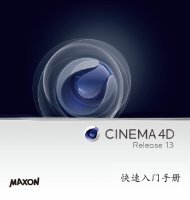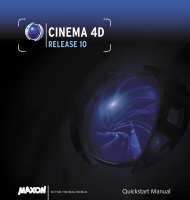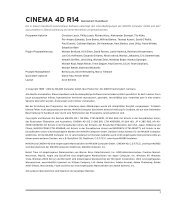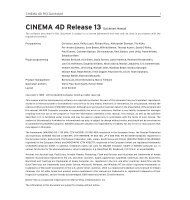Optional module - Maxon Computer
Optional module - Maxon Computer
Optional module - Maxon Computer
You also want an ePaper? Increase the reach of your titles
YUMPU automatically turns print PDFs into web optimized ePapers that Google loves.
CINEMA 4D R11 Quickstart – MOCCA<br />
MOCCA also includes three very powerful tools: Morph, Vamp and Visual Selector.<br />
Like the PoseMixer tool, the Morph tag lets you create various facial expressions for your characters and morph<br />
between them. The difference is that with Morph, you no longer need to work with copies of the original mesh,<br />
as was required in Posemixer for R9. Your polygon object acts as the reference and a “base morph” (starting<br />
position for all following morphs) and “target morph” are created in the Morph tag. You select the morph target<br />
in the Morph tag and change the mesh...finished!<br />
You create another morph target for each additional pose and model the poses one after the other. All the<br />
expressions are stored in a single tag. Also, when using the Morph tool, there’s no need to worry if you have<br />
to make changes to the mesh after creating the poses. The poses will still work! Suppose you’ve created all the<br />
poses for your character, but decide it would look much better with a second nose. The Morph tool will still<br />
happily morph between the poses.<br />
Vamp gives you the possibility to transfer data from object to another, including selection information, Texture<br />
tags, vertex maps and UVs. You can even transfer facial poses from one character to another!<br />
Visual Selector is a great help with day-to-day animation. You load a render of your character into Visual<br />
Selector‘s background (or use Visual Selector‘s default character picture) and place your character‘s controllers<br />
onto the picture in the appropriate places. Visual Selector removes the need to keep looking for your character‘s<br />
controls in the Object hierarchy. Everything is now represented visually and you can, for example, select the<br />
foot controller by clicking on it directly in the picture. You want to move the eyes? No problem. Click on the<br />
controller for the eyes directly in the picture.<br />
You‘ll find the MOCCA commands in the main menu under “Character”, or you may prefer to integrate the<br />
MOCCA toolbar into the layout (as described for the Dynamics toolbar in the “Dynamics” chapter).<br />
If you’re new to the process of rigging characters, the following overview may help.<br />
As with a real human, your character needs a skeleton of bones (or in our case, joints) in order to be able to<br />
move around in the world. You place the joints inside the character’s mesh. The joints are linked to the mesh<br />
via a Weight tag and Skin deformer so that each joint knows which part of the geometry to affect.<br />
You can weight joints by selecting them and painting directly onto the mesh using the Weight tool. While the<br />
Weight tool is active, the mesh is displayed black and the currently painted weighting is shown in white. The<br />
joint now knows it should affect the white painted parts of the mesh only. In the active Weight tool mode,<br />
weighting is shown for the selected joints. Each joint has its own weighting.<br />
The joints must be arranged into a hierarchy in the Object Manager in a similar structure to the bones in your<br />
own body. In real life, when you move your upper arm, the lower arm and hand move with it because they are<br />
effectively children of the upper arm.<br />
Likewise, in CINEMA 4D’s Object Manager, the elbow and wrist joints must be children of the shoulder joint.<br />
If you move the shoulder joint, the child joints will move with it together with the mesh weighted to the child<br />
joints — even though the shoulder joint is weighted to the upper arm only.<br />
As previously mentioned, each child joint has its own weighting and moves the parts of the mesh not weighted<br />
to the shoulder joint.<br />
Don’t worry if this seems complex. All will be explained in the rest of this chapter.<br />
167









